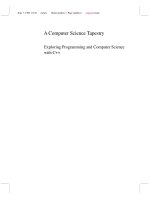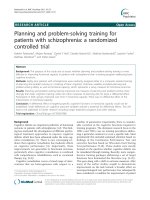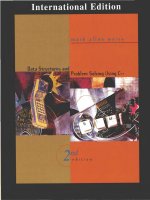programming and problem solving with c++ 6th by dale ch05
Bạn đang xem bản rút gọn của tài liệu. Xem và tải ngay bản đầy đủ của tài liệu tại đây (558.2 KB, 92 trang )
Chapter 5
Conditions, Logical Expressions,
and Selection Control Structures
Chapter 5 Topics
●
Data Type bool
●
Using Relational and Logical Operators to Construct and Evaluate Logical Expressions
●
If-Then-Else Statements
Chapter 5 Topics
●
If-Then Statements
●
Nested If Statements for Multi-way Branching
●
Testing the State of an I/O Stream
●
Testing a C++ Program
Flow of Control
Flow of Control is the order in which program statements are executed
What are the possibilities?
Flow of Control
●
Sequential unless a “control structure” is used to change
the order
●
Two general types of control structures
Selection (also called branching)
Repetition (also called looping)
bool Data Type
●
Type bool is a built-in type consisting of just
two
values, the constants true and false
●
We can declare variables of type bool
bool hasFever;
// true if has high temperature
bool isSenior; // true if age is at least 55
C++ Control Structures
●
Selection
if
if . . . else
switch
●
Repetition
for loop
while loop
do . . . while loop
Expressions
Control structures use logical expressions to make choices,
which may include:
6 Relational Operators
<
<=
>
>=
==
3 Logical Operators
!
&&
||
!=
6 Relational Operators
are used in expressions of form:
ExpressionA
Operator
temperature
rain
B * B - 4.0 * A * C
hours
abs (number)
initial
ExpressionB
>
>=
<
<=
==
humidity
average
0.0
40
35
!=
‘Q’
Given
int
x, y;
x = 4;
y = 6;
Expression
x < y
Value
true
x + 2 < y
false
x != y
true
x + 3 >= y
true
y == x
false
y == x+2
true
y = x + 3
7
(true)
Comparing Strings
●
Two objects of type string (or a string object and a C
string) can be compared using the relational operators
●
A character-by-character comparison is made using the ASCII
character set values
●
If all the characters are equal, then the 2 strings are
equal. Otherwise, the string with the character with
smaller ASCII value is the “lesser” string
/>
string
myState;
string
yourState;
myState = “Texas”;
yourState = “Maryland”;
Expression
Value
myState == yourState
false
myState > yourState
true
myState == “Texas”
true
myState
true
<
“texas”
Operator
Meaning
!
NOT
*, / , %
Addition, Subtraction
<
Less than
Less than or equal to
>
Left
Left
Left
Left
Greater than
>=
Greater than or equal to
==
Is equal to
!=
Is not equal to
&&
AND
||
OR
=
Right
Multiplication, Division, Modulus
+ , <=
Associativity
Left
Left
Left
Left
Left
Left
Assignment
Right
Logical
Expression
! p
p && q
Meaning Description
NOT p
p AND q
! p
is false if p is true
! p
is true
if p is false
p && q is true if
both
p
and q
are true.
It is false otherwise.
p || q
p OR q
p || q is true if either
p or q or both are true.
It is false otherwise.
Logical Operation
int
age;
bool
isSenior,
hasFever;
float temperature;
age = 20;
temperature = 102.0;
isSenior = (age >= 55); // isSenior is
false
hasFever = (temperature > 98.6);
// hasFever is
true
Expression
Value
isSenior && hasFever
false
isSenior
true
||
hasFever
! isSenior
true
! hasFever
false
What is the value?
int age, height;
age = 25;
height = 70;
Expression
!(age
< 10)
!(height
> 60)
Value
?
?
“Short-Circuit” Evaluation
●
C++ uses short circuit evaluation of logical expressions
●
This means logical expressions are evaluated left to right and
evaluation stops as soon as the final truth value can be
determined
Short-Circuit Example
int age, height;
age = 25;
height = 70;
Expression
(age > 50)
&&
(height > 60)
false
Evaluation can stop now because result of && is only true
when both sides are true; thus it is already determined the
expression will be false
More Short-Circuiting
int
age, height;
age = 25;
height = 70;
Expression
(height > 60)
||
(age > 40)
true
Evaluation can stop now because result of || is true if
either side is true; thus it is already determined that the
expression will be true
What happens?
int age, weight;
age = 25;
weight = 145;
Expression
(weight < 180)
&&
(age >= 20)
true
Must still be evaluated because truth
value
of entire expression is not yet known
(Why?)
What happens?
int
age, height;
age = 25;
height = 70;
Expression
! (height > 60)
||
(age > 50)
true
false
Does this part need to be evaluated?
Write an expression for each
•
•
•
•
taxRate is over 25% and income is less than $20,000
temperature is less than or equal to 75° or humidity is less
than 70%
age is over 21 and age is less than 60
age is 21 or 22
Some Answers
(taxRate > .25) && (income < 20000)
(temperature <= 75) || (humidity < .70)
(age > 21) && (age < 60)
(age == 21) || (age == 22)
Use Precedence Chart
int
number;
float
x;
number
!= 0
&&
x
<
1 / number
/
has highest priority
<
next priority
!=
next priority
&&
next priority
What happens if Number has value 0?
Run Time Error (Division by zero) occurs









